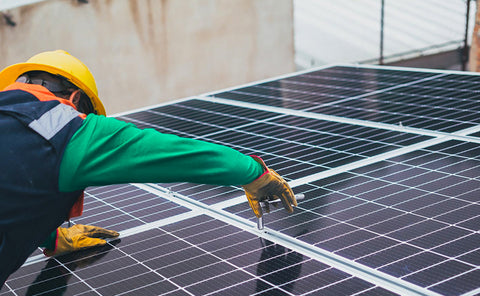
Does shade really affect the solar panel

As we all know, the efficiency of solar panels are affected by many factors including the weather, the angle of solar panel installation and the durability of solar panels, etc. And many solar users ask whether the shade affects the work of solar panels? The answer is: just a little shade can affect a solar panel`s power output dramatically.
Diffuse shade from a “soft” source, like a distant tree branch or cloud can significantly reduce the amount of light reaching a solar panel’s cells. “Hard” sources stop light from reaching solar cells, such as debris or bird dropping sitting on top of the panel. If even one full cell is hard shaded, the voltage of a solar panel drops to half in order to protect itself. If enough cells are hard shaded, the module will not convert any energy. In fact, solar panel shading can become a significant drain of energy on the entire system over time.
Partial shading of even one cell on a 36-cell solar panel will reduce its power output. Because all cells are connected in a series string, the weakest cell will bring the others down to its reduced power level. Therefore, whether half of one cell is shaded, or half a row of cells is shaded, the power decrease will be the same and proportional to the percentage of area shaded, in this case 50 percent.
When a full cell is shaded, it can use energy produced by the remainder of the cells, and trigger the solar panel to protect itself. The solar panel will route the power around that series string. If even one full cell in a series string is shaded, as seen on the right, it will most likely cause the module to reduce its power level to half of its full available value. If a row of cells at the bottom of a solar panel is fully shaded, the power output may drop to zero. The best way to avoid a drop in output power is to avoid shading whenever possible.
A solar panel affects an array in much the same way a single cell affects a solar panel. In a centralized inverter system, where panels are strung in series, if only one of the solar panels is shaded in an array, the rest of the solar panels’ output diminishes. When choosing a grid tie solar power system for their home or business, folks often prefer the tried and true technology of a centralized inverter systems. And the price tag on these is pretty good.
If one solar panel is shaded in either of these systems, the rest of the array’s panels can still operate at full capacity.
(XINPUGUANG provides DC to DC power optimization for each solar panel, while microinverters provide DC to AC optimization at the module level.) Both of these systems allow solar panels to be facing different orientations giving you more design flexibility if part of your installation site is in the shade. A centralized inverter system requires panels to facing the same direction.
Facebook: Xinpuguang Solar Panel
Instagram: xinpuguangsolar
Pinterest: XinpuguangSolarPanels
Homepage: https://xinpuguangsolar.com
Email address: Philip@isolarparts.com
- 選択範囲を選択すると、ページ全体が更新されます。
